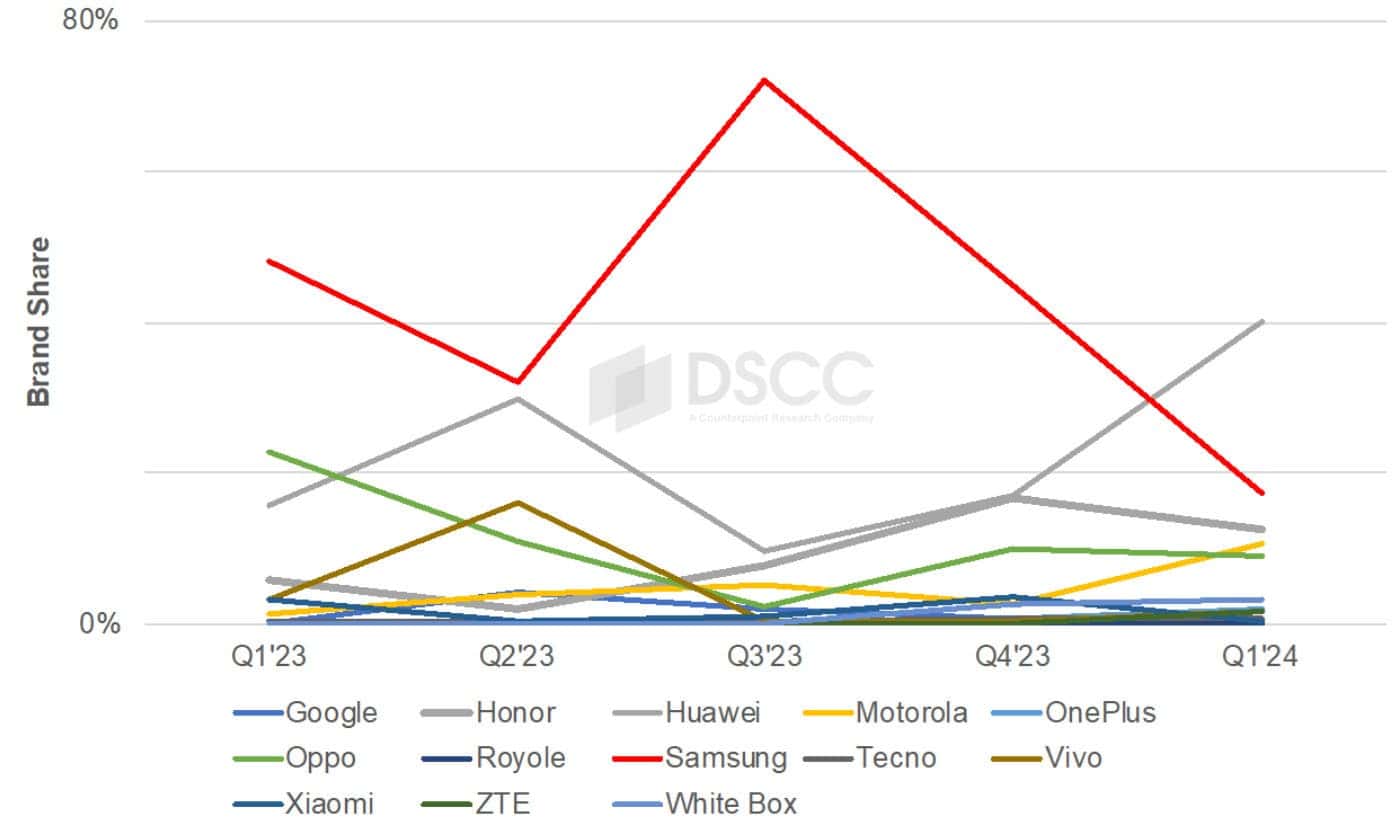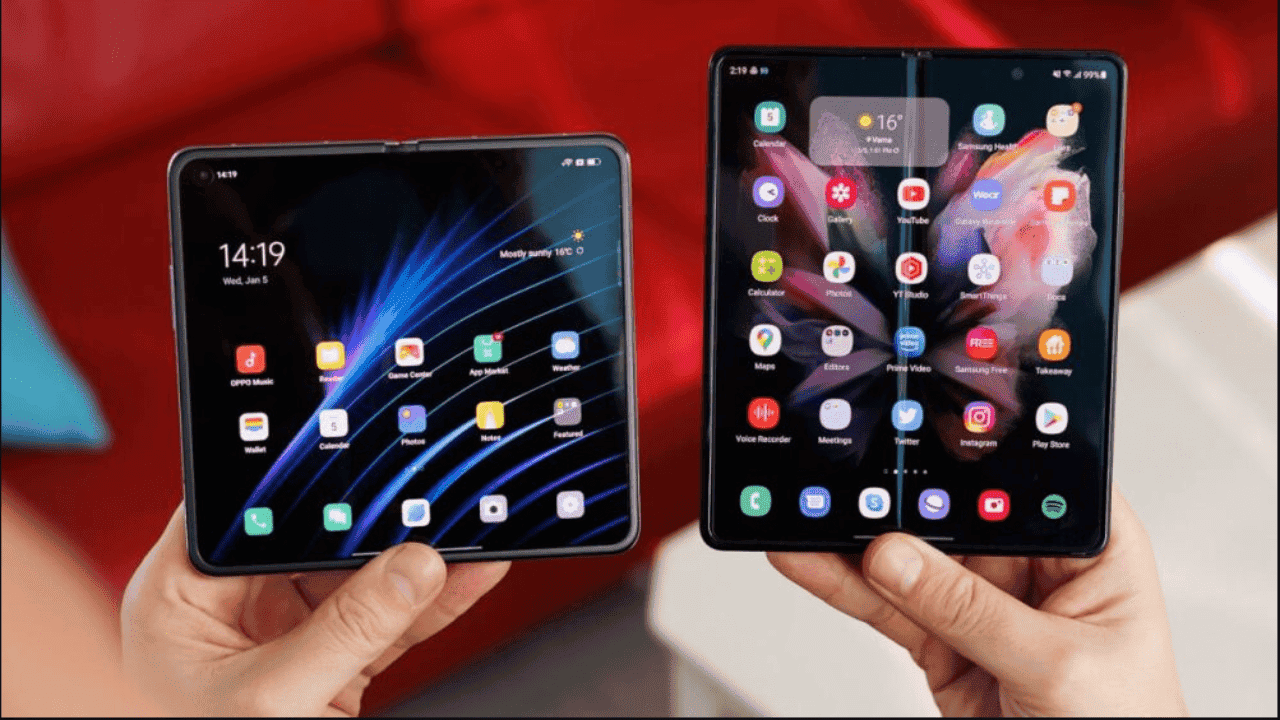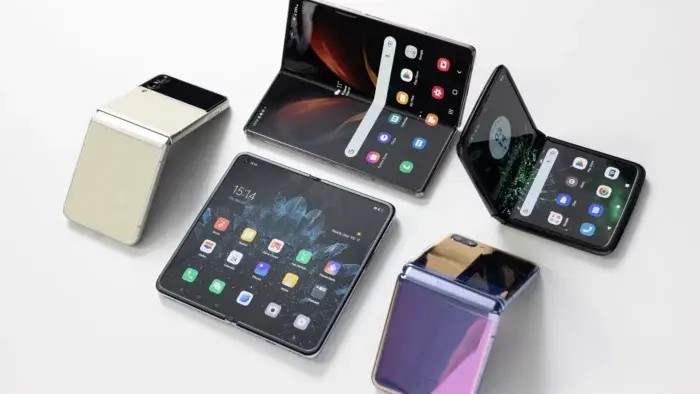The global smartphone market has been experiencing a period of sluggish growth, with some analysts even calling it a recession. But within this landscape, a segment is defying the trend: foldable smartphones. These innovative devices, with their unique ability to unfold into a larger screen, are seeing significant growth, offering a glimpse into the future of mobile technology.
Foldables Defy the Downturn: A Market Segment in a Stagnant Smartphone Landscape

According to a recent study by Display Supply Chain, sales of foldable smartphones in Q4 2023 surged by a remarkable 33% compared to the same period in 2022, reaching a total of 4.2 million units. This upward trajectory is expected to continue. With analysts predicting a phenomenal 105% year-on-year increase in sales during the current first quarter of 2024.
Huawei’s Ascendency in the Clamshell Market
One of the most intriguing developments within the foldable market is the potential shift in leadership for clamshell-style foldables. Traditionally dominated by Samsung’s Galaxy Z Flip series, the market may be witnessing a power struggle. Counterpoint Research suggests that Huawei, a major player in the smartphone industry, could potentially outstrip Samsung in terms of clamshell market share. This shift hinges on the success of Huawei’s upcoming Pocket 2 model. Early indications are positive, with reports of Huawei increasing its purchases of foldable display panels from BOE in Q4 2023, suggesting anticipation of high sales volume for the Pocket 2.
A Diversifying Landscape: Brand Distribution and Top Performers
The foldable smartphone market is no longer a one-horse race. While Samsung remains a prominent player, with four of the top 10 best-selling models belonging to their Galaxy Z series (Z Flip 5 and Z Fold 5), other brands are making their mark. Honor and OPPO each boast two models in the top 10, with the Honor Magic Vs 2 and OPPO Find N3 Flip showcasing the growing capabilities of these companies in the foldable space. Even established players like Xiaomi and emerging players like ZTE (with the Nubia Flip/Libero Flip) are contributing to the segment’s diversification. Leading the pack currently is the Samsung Galaxy Z Flip 5, followed closely by the Huawei Mate X5 and Honor Magic Vs 2.
Innovation Pipeline: A Surge of New Foldables on the Horizon
Riding the wave of consumer interest, the foldable market is poised for further expansion. Supply chain data analyzed by Counterpoint Research reveals a staggering number – 27 – of new foldable smartphones planned for launch before the end of 2024. Three models, the aforementioned Huawei Pocket 2, Honor Magic V2 RSR, and ZTE Nubia Flip/Libero Flip, have already been unveiled, whetting the appetites of tech enthusiasts. This influx of new devices from a variety of brands underscores the commitment of manufacturers to this evolving technology.

The Future of Foldables: A Catalyst for Market Growth
The success of foldable smartphones is a testament to consumer demand for innovative and immersive mobile experiences. The ability to transform from a compact phone into a larger tablet-like device caters to a growing desire for multi-tasking on the go. This trend, coupled with the continuous refinement of foldable display technology and a reduction in production costs, is expected to propel the segment to even greater heights in the coming years. Analysts predict that by 2027, global foldable smartphone shipments could surpass the 100 million mark.
The rise of foldables also presents a unique opportunity for app developers and content creators. As screen sizes expand and user interactions become more nuanced, new possibilities for app design and user interface optimization will emerge. This, in turn, will further enhance the user experience and drive market adoption.
However, certain challenges remain. Foldables currently come with a higher price tag compared to traditional smartphones. Additionally, concerns regarding durability and potential screen creases persist. As technology advances and production scales up, these issues are expected to be addressed. Paving the way for broader mainstream adoption.
The foldable smartphone market stands as a beacon of growth within a stagnant smartphone landscape. With major players innovating and new entrants joining the fray, consumers can expect a dynamic and exciting future for foldable devices. As this technology matures and overcomes existing hurdles, foldables have the potential to become the next standard in mobile technology. Revolutionizing the way we interact with our devices on the go.
Beyond Smartphones: The Foldable Revolution
Also, the potential applications of foldable technology extend beyond the realm of smartphones. Imagine a foldable tablet that transforms into a compact e-reader for easy portability, or a laptop with a foldable display that offers a seamless transition between a traditional clamshell format and a larger workspace. These possibilities hold immense promise for the future of mobile computing and entertainment. Blurring the lines between categories and catering to a wider range of user needs.
A Call for Collaboration: Fostering Innovation in a Competitive Landscape
So, the ongoing development of foldable technology necessitates collaboration between various stakeholders within the industry. Material scientists play a crucial role in creating more durable and flexible displays. While software developers need to adapt existing applications and design new ones to leverage the unique functionalities of foldable devices. Additionally, fostering open communication between manufacturers and display panel suppliers will be essential.





